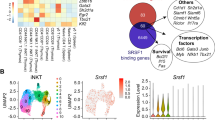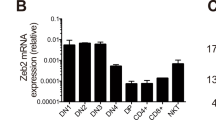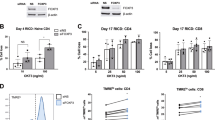Abstract
Programmed cell death, or apoptosis, is important in homeostasis of the immune system: for example, non-functional or auto-reactive lymphocytes are eliminated through apoptosis. One member of the tumour necrosis factor receptor (TNFR) family, Fas (also known as CD95 or Apo-1), can trigger cell death and is essential for lymphocyte homeostasis1,2. FADD/Mort1 (3–6) is a Fas-associated protein that is thought to mediate apoptosis by recruiting the protease caspase-8 (refs 7, 8). A dominant-negative mutant of FADD inhibits apoptosis initiated by Fas and other TNFR family members6,9,10,11,12,13,14. Other proteins, notably Daxx, also bind Fas and presumably mediate a FADD-independent apoptotic pathway15. Here we investigate the role of FADD in vivo by generating FADD-deficient mice. As homozygous mice die in utero, we generated FADD−/− embryonic stem cells and FADD−/− chimaeras in a background devoid of the recombination activating gene RAG-1, which activates rearrangement of the immunoglobulin and T-cell receptor genes. We found that thymocyte subpopulations were apparently normal in newborn chimaeras. Fas-induced apoptosis was completely blocked, indicating that there are no redundant Fas apoptotic pathways. As these mice age, their thymocytes decrease to an undetectable level, although peripheral T cells are present in all older FADD−/− chimaeras. Unexpectedly, activation-induced proliferation is impaired in these FADD−/− T cells, despite production of the cytokine interleukin (IL)-2. These results and the similarities between FADD−/− mice and mice lacking the β-subunit of the IL-2 receptor suggest that there is an unexpected connection between cell proliferation and apoptosis.
This is a preview of subscription content, access via your institution
Access options
Subscribe to this journal
Receive 51 print issues and online access
$199.00 per year
only $3.90 per issue
Buy this article
- Purchase on Springer Link
- Instant access to full article PDF
Prices may be subject to local taxes which are calculated during checkout





Similar content being viewed by others
References
Nagata, S. & Golstein, P. The Fas death factor. Science 267, 1449–1455 (1995).
Matiba, B., Mariani, S. M. & Krammer, P. H. The CD95 system and the death of a lymphocyte. Semin. Immunol. 9, 59–68 (1997).
Boldin, M. P.et al. Anovel protein that interacts with the death domain. J. Biol. Chem. 270, 7795–7798 (1995).
Chinnaiyan, A. M., O'Rourke, K., Tewari, M. & Dixit, V. M. FADD, a novel death domain-containing protein, interacts with the death domain of Fas and initiates apoptosis. Cell 81, 505–512 (1995).
Kischkel, F. C.et al. Cytotoxicity-dependent APO-1 (Fas/CD95) associated proteins form a death-inducing signaling complex (DISC) with the receptor. EMBO J. 14, 5579–5588 (1995).
Zhang, J. & Winoto, A. Amouse Fas-associated protein with homology to the human Mort1/FADD protein is essential for Fas-induced apoptosis. Mol. Cell. Biol. 16, 2756–2763 (1996).
Muzio, M.et al. FLICE, a novel FADD-homologous ICE/CED-3-like protease, is recruited to the CD95 (Fas/APO-1) death-inducing signaling complex. Cell 85, 817–827 (1996).
Boldin, M. P., Goncharov, T. M., Goltsev, Y. V. & Wallach, D. Involvement of MACH, a novel MORT1/FADD-interacting protease, in Fas/APO-1 and TNF receptor-induced cell death. Cell 85, 803–815 (1996).
Chinnaiyan, A. M.et al. FADD/MORT1 is a common mediator of CD95 (Fas/APO-1) and tumor necrosis factor receptor-induced apoptosis. J. Biol. Chem. 271, 4961–4965 (1996).
Hsu, H., Shu, H.-B., Pan, M.-G. & Goeddel, D. V. TRADD-TRAF2 and TRADD-FADD interactions define two distinct TNF receptor 1 signal transduction pathways. Cell 84, 299–308 (1996).
Bodmer, J.-L.et al. TRAMP, a novel apoptosis-mediating receptor with sequence homology to tumor necrosis factor receptor 1 and Fas(Apo-1/CD95). Immunity 6, 79–88 (1997).
Chinnaiyan, A. M.et al. Signal transduction by DR3, a death domain-containing receptor related to TNFR-1 and CD95. Science 274, 990–992 (1996).
Kitson, J.et al. Adeath-domain-containing receptor that mediates apoptosis. Nature 384, 372–375 (1996).
Marsters, S. A.et al. Apo-3, a new member of the tumor necrosis factor receptor family, contains a death domain and activates apoptosis and NF-κB. Curr. Biol. 6, 1669–1676 (1996).
Yang, X., Khosravi-Far, R., Chang, H. Y. & Baltimore, D. Daxx, a novel Fas-binding protein that activates JNK and apoptosis. Cell 89, 1067–1076 (1997).
Chen, J., Lansford, R., Stewart, V., Young, F. & Alt, F. W. RAG-2-deficient blastoyst complementation: An assay of gene function in lymphocyte development. Proc. Natl Acad. Sci. USA 90, 4528–4532 (1993).
Mortensen, R. M., Conner, D. A., Chao, S., Geisterfer-Lowrance, A. A. & Seidman, J. G. Production of homozygous mutant ES cells with a single targeting construct. Mol. Cell. Biol. 12, 2391–2395 (1992).
Mombaerts, P.et al. RAG-1-deficient mice have no mature B and T lymphocytes. Cell 68, 869–877 (1992).
Chu, K., Niu, X. & Williams, L. T. AFas-associated protein factor, FAF1, potentiates Fas-mediated apoptosis. Proc. Natl Acad. Sci. USA 92, 11894–11898 (1995).
Sato, T., Irie, S., Kitada, S. & Reed, J. C. FAP-1: a protein tyrosine phosphatase that associates with Fas. Science 268, 411–415 (1995).
Stanger, B. Z., Leder, P., Lee, T.-H., Kim, E. & Seed, B. RIP: a novel protein containing a death domain that interacts with Fas/APO-1 (D95) in yest and causes cell death. Cell 81, 513–523 (1995).
Ogasawara, J., Suda, T. & Nagata, S. Selective apoptosis of CD4+CD8+ thymocytes by the anti-Fas antibody. J. Exp. Med. 181, 485–491 (1995).
Hernandez-Caselles, T. & Stutman, O. Immune functions of tumor necrosis factor. J. Immunology 151, 3999–4012 (1993).
Suzuki, H.et al. Derugulated T cell activation and autoimmunity in mice lacking interleukin-2 receptor β. Science 268, 1472–1476 (1995).
Fournel, S., Genestier, L., Robinet, E., Flacher, M. & Revillard, J.-P. Human T cells require IL-2 but not G1/S transition to acquire susceptibility to Fas-mediated apoptosis. J. Immunol. 157, 4309–4315 (1996).
Lenardo, M. J. The molecular regulation of lymphocyte apoptosis. Semin. Immunol. 9, 1–5 (1997).
Parijs, L. V.et al. Functional responses and apoptosis of CD25 (IL-2Rα)-deficient T cells expressing a transgenic antigen receptor1. J. Immunol. 158, 3738–3745 (1997).
Lenardo, M. J. Interleukin-2 programs mouse alpha beta T lymphocytes for apoptosis. Nature 353, 858–861 (1991).
Ramirez-Solis, R., Davis, A. C. & Bradley, A. Gene targeting in embryonic stem cells. Methods Enzymol. 225, 855–878 (1993).
Schmid, I., Uittenbogaart, C. H., Keld, B. & Giorgi, J. V. Arapid method for measuring apoptosis and dual-color immunofluorescence by single laser flow cytometry. J. Immunol. Methods 170, 145–157 (1994).
Acknowledgements
We thank members of the Winoto, Allison, Robey and Raulet groups for discussions; P. Schow for technical assistance; A. Nagy, R. Nagy and W. Abramow-Newerly for the R1 ES cells; R.Jaenisch for the J1 ES cells; and E. Robey, B. Ortiz and H. Kasler for critical reading of the manuscript. This work is supported in part by grants from the NIH, National Science foundation and the Keck Foundation. J.Z. was supported by an Irvington Institute fellowship and is a Leukemia Society of America special fellow.
Author information
Authors and Affiliations
Corresponding author
Rights and permissions
About this article
Cite this article
Zhang, J., Cado, D., Chen, A. et al. Fas-mediated apoptosis and activation-induced T-cell proliferation are defective in mice lacking FADD/Mort1. Nature 392, 296–300 (1998). https://doi.org/10.1038/32681
Received:
Accepted:
Issue Date:
DOI: https://doi.org/10.1038/32681
This article is cited by
-
Necroptosis, pyroptosis and apoptosis: an intricate game of cell death
Cellular & Molecular Immunology (2021)
-
A potential role of green engineered TiO2 nanocatalyst towards enhanced photocatalytic and biomedical applications
Environmental Science and Pollution Research (2021)
-
RIPK1 can mediate apoptosis in addition to necroptosis during embryonic development
Cell Death & Disease (2019)
-
Redundant and receptor-specific activities of TRADD, RIPK1 and FADD in death receptor signaling
Cell Death & Disease (2019)
-
TRADD regulates perinatal development and adulthood survival in mice lacking RIPK1 and RIPK3
Nature Communications (2019)
Comments
By submitting a comment you agree to abide by our Terms and Community Guidelines. If you find something abusive or that does not comply with our terms or guidelines please flag it as inappropriate.



